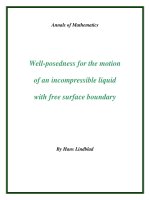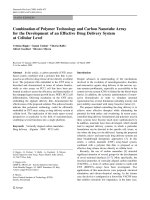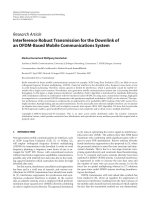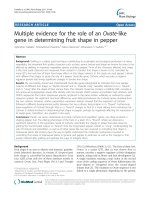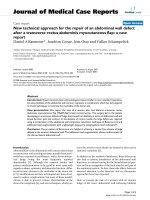Template-for-the-Review-of-an-Existing-Graduate-Program-version-6
Bạn đang xem bản rút gọn của tài liệu. Xem và tải ngay bản đầy đủ của tài liệu tại đây (367.81 KB, 43 trang )
Brief for the Periodic Appraisal
of the
MA / MSc and PhD
in
Program Name
Submitted to the
Senate Subcommittee on Program Review – Graduate
Western University
Date
This document is confidential to the review process…
Send the electronic version of the completed template to:
Candace Loosley, Assistant to the Vice-Provost, School of Graduate and Postdoctoral Studies
E-mail: (updated May 31, 2017)
VOLUME 1
Program Name
Table of Contents
INTRODUCTION...............................................................................................................2
RECRUITMENT AND ADMISSION...................................................................................9
Recruitment Strategy.........................................................................................................9
FACULTY MEMBERS IN THE PROGRAM, RESEARCH FUNDING IN THE PROGRAM,
AND GRADUATE SUPERVISION AND TEACHING.......................................................10
PHYSICAL, PROFESSIONAL DEVELOPMENT AND FINANCIAL RESOURCES........19
OUTCOMES – ENROLMENT AND COMPLETION SUMMARIES.................................28
Send the electronic version of the completed template to:
Candace Loosley, Assistant to the Vice-Provost, School of Graduate and Postdoctoral Studies
E-mail: (updated May 31, 2017)
1
For New Program Brief – not applicable for program review.
Insert section for ministry questions.
2
INTRODUCTION
Brief Overview of Program
•
•
•
•
•
•
Program History (how long has it been in existence)
Current program identity (e.g. how would you describe your program to potential
students)
Vision statement going forward
Degree(s) Awarded
o note any thesis, non-thesis options
o note any participation in Collaborative Specializations
o note delivery or program off-campus
Include links to your program’s websites and social networking pages
Include link to Western’s Strategic Plan
/>
Unique and Innovative Features
•
•
•
•
Note if the program is accredited by a professional body;
Note any unique opportunities through partnerships with other departments or
units;
Note any partnerships or agreements with other Universities; for example, dual
degrees, additional credentialing opportunities
Note any special training opportunities or internships available to students
Professional Development Strategy
•
•
•
Describe your program’s view of the importance of professional development to
your students today (describe the job markets your program strives to prepare
students for)
Describe your program’s commitment to supporting the professional development
of your students
Explain
o the professional development opportunities embedded in your program
curriculum (milestones),
o opportunities offered within your department (speaker series, conference
funding), and
o how your program supports student engagement in broader professional
development opportunities offered at Western and beyond (Own Your
Future, TSC, MyGradSkills.ca etc)
3
Fields of Research in the Program
(Please note that a “field of research” is a term used for the public declaration of an area
of approved strength (or an area of concentration or an area of specialization) within a
program and represents a specific area that the program wishes to advertise. Fields
must be formally approved through the review process.)
• List and describe your current fields of research for each of your degrees. Include
a brief summary of each field.
•
Fields can be displayed on the transcript, parchment, or both. Currently, your
fields are (are not)…… Indicate whether you are proposing a change to this, and
if so, what that change is. SGPS to provide what is currently approved (table)
•
Note any changes to fields that will be proposed in this brief. (Discuss any
changes in more detail under the Program Innovation and Modification section
below).
Review Concerns Expressed in Previous Appraisal and Actions Taken
•
Address concerns expressed in the previous review. Identify each concern and
the action taken to address it. If no concerns were expressed, note this in this
section.
Ongoing Program Evaluation and Redesign Process
Graduate Program Structure
• Describe the administrative structure that supports the graduate program; include
a description of the composition and responsibilities of the graduate program
committee.
Processes for Ongoing Evaluation
• Explain the self-study processes your program uses to assess and review
program design on an ongoing basis. For example, outline/describe any annual
retreats, surveys, meetings, focus groups that the program undertakes to review
and assess the program.
Summary of Current Self-Study
• Describe the method and results of your current self-study.
Describe Program Innovation(s) and Modification(s) since the last
Review
•
Provide a summary of major and minor modifications approved since the last
review. (include in appendix)
4
•
SGPS will provide all the major and minor modifications that have been
approved.
Describe Program Innovation(s) and Modification(s) proposed in this
Review
•
Identify any modifications being proposed in this review
o A brief description of the proposed modification
o A brief description of the rationale for the modification (e.g., explain how
the program will be improved and/or how students will benefit from the
proposed modification)
o A description of the current state of the program (in terms of the aspect
under consideration); and a comparison to what the program will look like
after the modification, highlighting the changes
Current Program
Proposed changes
o The timeline for introducing the modification
o An explanation of how current student will be affected by the modification
and a plan for ensuring current students are not negatively affected by the
change
o A description of how the modification may affect any other programs and
students in other programs (e.g., how the modification may affect students
in a collaborative or a joint program)
o Evidence that all appropriate consultation has taken place (e.g., any
affected programs)
Graduate Program Learning Outcomes
•
Articulate the program learning outcomes aligned with each Graduate Degree
Level Expectations (GDLE) at the Master’s and Doctoral level (and for each
field if relevant).
1.
2.
3.
4.
5.
6.
Depth and Breadth of Knowledge
Research and Scholarship
Level of Application of Knowledge
Professional Capacity / Autonomy
Level of Communication Skills
Awareness of Limits of Knowledge
GDLES, Program Level Learning Outcomes, and Methods for
Supporting and Evaluating GDLEs
•
Work with Teaching Support Centre to develop appropriate program level
learning outcomes
5
•
•
List the Program Level Learning Outcomes and Describe the Methods for
Supporting and Evaluating Each GDLE
Use a separate table for master’s and doctoral level expectations and for
different fields under each if relevant.
6
Ontario Graduate
Degree Level
Expectations
Program-level Learning Outcomes
1. Depth &
Breadth of
Knowledge
a)
Evaluate and demonstrate the effectiveness of usercentered information systems, services and resources for
individual users and diverse communities in a networked
global society within which information organizations and
information professionals operate. (LIS Western)
b)
produce and defend an original significant contribution
to knowledge (Oregon State University
/>c)
construct original historical arguments based on
primary source material research
( />d)
evaluate and integrate information and points of view
from contrasting sources (modified from music Western)
a)
Critically apply theories, methodologies and knowledge
to address fundamental questions in their primary area of
study (Washington State University
( />b)
engage with a range of research in their field,
contributing to larger scholarly conversations (Music Western)
a)
accurately describe works of art, balancing
consideration of artist’s intention with viewer’s response, and
contextualizing the work in question
( />b)
conduct research that applies existing knowledge to
the critical analysis of new research questions or issues, or to
2. Research &
Scholarship
3. Level of
Application of
Knowledge
How does the
program
support
achievement of
each GDLE?
How does the
program
evaluate the
achievement of
each GDLE?
7
Ontario Graduate
Degree Level
Expectations
4. Professional
Capacity /
Autonomy
5. Level of
Communication
Skills
6. Awareness of
Limits of
Knowledge
Program-level Learning Outcomes
familiar research questions in a new setting
a) convey a broad understanding of historical material
suitable for teaching( />b) Conduct research that meets the ethical standards in
biology and their sub-discipline, including proper
attribution, data integrity, and respectful treatment of
colleagues and ethical treatment of animals and the
environment. (Western biology learning outcomes)
a)
Interact productively with people from diverse
backgrounds as both leaders/mentors and team members
with integrity and professionalism. (Washington State
University ( />b)
Write in a distinctive, clear, forceful, and jargon-free
prose style that reflects fluency in fundamental principles and
practices of critical writing (modified from
/>a)
Explain, analyse and interpret professional and
scholarly literature, research data and information resources
to articulate their implications for LIS and related fields of
knowledge and practice.
b)
Explain and discuss their specific biological research
with a member of a related sub-discipline, and respond
productively to constructive criticism.
c)
Appreciate multiple intellectual viewpoints and ways of
How does the
program
support
achievement of
each GDLE?
How does the
program
evaluate the
achievement of
each GDLE?
8
Ontario Graduate
Degree Level
Expectations
Program-level Learning Outcomes
knowing, and understand how these produce an awareness
of the limits of knowledge offered by any specific discourse.
(modified from Music Western)
How does the
program
support
achievement of
each GDLE?
How does the
program
evaluate the
achievement of
each GDLE?
9
Program Design Components (required, mandatory and optional
courses, milestones and thesis/OIP/MRP etc) aligned with ProgramLevel Learning Outcomes and GDLES
•
•
List each program design components’ learning outcomes and indicate which
program learning outcome(s) and GDLE(s) that is fulfilled.
Use a separate table for master’s and doctoral level programs and for different
fields if relevant.
RECRUITMENT AND ADMISSION
Recruitment Strategy
•
•
Describe your recruitment strategy and communication plan as relevant (see
SGPS recruitment portal and instructions for creating communication plans)
Identify and comment on recruitment challenges
Program Admission Requirements
•
•
•
Minimum SGPS requirements can be found here (add link).
Provide your program specific admission requirements for each degree, and by
field as relevant
Include your criteria for English language proficiency
TIMELINE AND PROGRESSION
Degree Timeline
•
•
Lay out the temporal sequencing of your program design components over your
program duration in the table below (by degree and field if relevant).
Describe how the timeline is altered for part-time students
Progression requirements
•
Explain your program progression requirements
Describe your process for evaluating student progress in each degree
Include how student progress is monitored and evaluated (e.g., annual progress
evaluations and reports; quarterly meeting of the student with his/her advisory
committee)
10
FACULTY MEMBERS IN THE PROGRAM, RESEARCH
FUNDING IN THE PROGRAM, AND GRADUATE
SUPERVISION AND TEACHING
Faculty Members in the Program
Table 1 lists the faculty members involved in the graduate program, identifies their home
unit and SGPS membership, and indicates gender. The intent of this table is to
establish the strength and the degree of involvement of the faculty complement
participating in each field of the graduate program and whose CVs are provided in
Volume II of the Brief. This is an important element in the assessment of program
quality.
Describe the composition of the faculty, its appropriateness for offering the program,
and the commitment to ensuring the ongoing participation of faculty members. For
example:
There are [X] full-time Primary professors. These members will have primary
responsibility for delivering the required courses in the program.
There are [X] members in the program who are not Primary or Supporting faculty,
but contribute to the program through teaching of graduate courses and
professional training; they provide valuable expertise in .... [If applicable]
There are [X] cross-appointed professors from other academic units. [X] adjunct
professors, [X] clinical professors, and [X] emeritus professors.
Comment on the professional credentials of faculty members as relevant to the
program. Note the number or proportion of faculty who have professional credentials or
expertise relevant to the program.
Comment on the distribution of responsibilities across the ranks of professors as
primary or supporting members of the program.
Comment on involvement of non-tenure track members of the program.
Using the format of Table 1, list the faculty members in the program according to the
descriptions below (e.g., Primary, Supporting, Emeritus, Other).
If the program currently has fields, or is proposing fields, faculty members must be listed
by field.
Primary members:
tenured or tenure-track faculty members whose graduate involvement will be
primarily in the graduate program
non-tenure-track faculty members, clinical faculty, and institute scientists whose
graduate involvement will be primarily in the graduate program
11
Supporting members:
tenured or tenure-track faculty members who are involved in teaching and/or
supervision in other graduate program(s) in addition to being a member of the
graduate program
non-tenure track faculty members, clinical faculty, and institute scientists who are
involved in teaching and/or supervision in other graduate program(s) in addition
to being a member of the graduate program
Emeritus
emeritus professors with SGPS Membership who will be contributing to the
program
Other
includes persons from outside of the university, such as those from government
laboratories, industry, or professional practice appointed as adjunct professors;
also includes non-core faculty who will participate in the teaching of graduate
courses.
12
TABLE 1 - SGPS will supply the table template and membership listing; the Program will indicate field membership.
Faculty Members by Field
Category
1
Faculty Name
Rank
Gender
Home Unit
2
SGPS membership
level3
Fields of
Research
1
2
3
4
1
Categories are defined as:
Primary - core faculty members whose graduate involvement is primarily in the graduate program under review, Supporting - core faculty members who are involved in
teaching and/or supervision in other graduate program(s) in addition to being a core member of the graduate program under review, Emeritus - emeritus professors with
supervisory privileges, Other - includes persons appointed from governmental laboratories or industry as adjunct professors; also includes non-core faculty who participate
in the teaching of graduate courses.
2
The budget unit paying the salary: department, school, research centre, institute or other.
3
The level of SGPS Membership held by the faculty member for the graduate program under review.
13
Research Funding
This section is intended to show the amount of funding available to support faculty
research and potentially available to support students’ work, either through the provision
of stipends or materials for the conduct of the research.
Comment on whether there has been an [increase/decrease] in research funding e.g.,
total, source, field (give percentages if useful)]. This can be attributed to [ ...] [e.g.,
granting council budget changes, increase/decrease in number of professors, recent
appointments, changes in affiliation and contacts with industry, alternative sources of
research funding (e.g., foundations, etc.) Refer to Table 2 data where appropriate.
If appropriate, provide information and comments on infrastructure funding or any
special funding that has an impact on the program. Provide data to support comments.
Table 2 presents research funding received by the faculty members in the program by
source and year for the past five years. Figures represent the sum total of research
revenue for all faculty members in the program as submitted through Western’s ROLA
system.
The heading Granting Councils includes Tri-Council grant revenue from SSHRC, CIHR
and NSERC.
The heading Other Peer Adjudicated includes grant revenue from foundation grants and
externally peer adjudicated grants.
The heading Contracts includes research revenue from corporations and external
contracts.
The heading Other includes equipment grants, conference grants, and similar grants.
The heading Internal Grants includes institutional grants and research funding.
When present, a separate column is included for CFI grants.
Grants for travel and publication awarded to faculty should not be included in this table
(they may be included in the appropriate place in individual CVs or in a separate table).
14
Table 2 - Completed by SGPS
Research Funding of Members in the Program for the Past Five Years
Year1
Granting
Councils2
Other Peer
Adjudicated3
Contracts4
2005-06
2006-07
2007-08
2008-09
2009-10
1
The Tri-Council fiscal year (April 1 to March 31)
2
Tri-Council grants from SSHRC, CIHR and NSERC
3
Foundation grants and externally peer adjudicated grants (e.g. Heart & Stroke Foundation)
4
Contracts include funding received from corporations
5
Other includes equipment grants, conference grants and similar grants.
6
Internal grants are defined as grant funding allocated by the University of Western Ontario
7
CFI Grants, if applicable
Other5
Internal
Grants6
CFI Grants7
Total (by Year)
$
$
$
$
$
-
15
Graduate Supervision
Comment on the supervisory capacity of the members in the program. Comment on the
distribution of graduate supervision across the members of the program. Comment on
any extreme values (i.e., any supervisors who carry an exceptionally large supervisory
load).
Table 3 lists the number of current and completed master's thesis supervisions, doctoral
thesis supervisions, and post-doctoral trainees, by faculty member in the program. If the
program offers different types of master’s degrees (e.g., MSc and MA) the table should
include separate columns for the different degree types.
For professional and non-thesis based programs the table can be revised to include
headings for the supervision of major research papers at the master’s level.
Alternatively, an additional table may be included to report the supervision of major
research papers. Do not combine the numbers for thesis supervision and major paper
supervision.
Faculty members should be listed under the categories specified in Table 1.
Table 3 is intended to provide an indication of the supervisory workload and experience,
past and present, of each member of the program. It is expected that Primary members
of the program would supervise more students in this program than would Supporting
members. Also, it is expected that Primary members would do most of their supervision
in this program, as opposed to other programs (i.e., for Primary members, it is expected
that the total number in other programs would not be considerably larger than the
number of students supervised in the program under review).
16
TABLE 3 – Completed by the Program
Completed and Current Numbers of Thesis Supervisions by Faculty Member1
Completed During Career at Western
Category
2
Faculty
Name
Master's
In
Program3
Other
Programs4
PhD
In
Program3
Other
Programs4
Current Students in Progress at Western
Post Doctoral
Scholars
In
Program3
Other
Programs4
Master's
In
Program3
Other
Programs4
PhD
In
Program3
Other
Programs4
Post Doctoral
Scholars
In
Program3
Other
Programs4
1
For reporting purposes, supervision of one student is assigned a value of 1. Co or joint supervision of one student is assigned a value of 0.5. Students who have withdrawn are not
included.
2
Categories are defined as:
Primary - core faculty members whose graduate involvement is primarily in the graduate program under review, Supporting - core faculty members who are involved in teaching
and/or supervision in other graduate program(s) in addition to being a core member of the graduate program under review, Emeritus - emeritus professors with supervisory
privileges, Other - includes persons appointed from governmental laboratories or industry as adjunct professors; also includes non-core faculty who participate in the teaching of
graduate courses.
3
In Program is defined as the total number of students/scholars supervised in the graduate program under review
4
All Programs is defined as total number of students/scholars supervised in all other programs the Supervisor holds membership at Western
17
Current and Recent Teaching Assignments
Provide an overview of the current and recent teaching workloads and experience of
faculty members in the program. It is expected that Primary members would be
involved in graduate teaching and would have most of their graduate teaching
responsibilities in this program. It is expected that Supporting members would have
most of their graduate teaching responsibilities in another graduate program.
Table 4 lists the graduate courses taught by each member of the graduate program over
the past three years. All graduate courses taught by the members are reported,
including those taught in other graduate programs.
Comment on any patterns of graduate teaching responsibility that are not consistent
with expectations. Note in the table (under the heading of “Comments”), any
circumstances having an impact on a member’s teaching (e.g., sabbatical leaves).
A footnote to the table is provided to explaining the course labeling so courses outside
of the program currently being reviewed can be easily identified.
18
TABLE 4 - Completed jointly by SGPS and the Program
Graduate Course Teaching Assignments in the Past Three Years1
Category2
Faculty Member
20XX-20XX
1
Year is defined as academic year, September 1 to August 31
2
Categories are defined as:
20XX-20XX
20XX-20XX
Comments
Primary - core faculty members whose graduate involvement is primarily in the graduate program under review, Supporting - core faculty members who are
involved in teaching and/or supervision in other graduate program(s) in addition to being a core member of the graduate program under review, Emeritus emeritus professors with supervisory privileges, Other - includes persons appointed from governmental laboratories or industry as adjunct professors; also includes
non-core faculty who participate in the teaching of graduate courses.
19
Commitment of Faculty Members from Other Programs and/or Other
Institutions
Explain the commitment to the program under review of faculty members from other
graduate programs. Indicate the number of faculty members from other programs who
contribute to the program under review and describe their roles (e.g., thesis supervisory,
advisory committee member, course instructor).
If the program relies significantly on the contributions of faculty members from other
programs (e.g., if required courses are taught by faculty members from other programs),
an indication of ongoing commitment of such contributions is required. Evidence of
significant commitment could include letters of support from the Department Chairs
and/or Deans of the faculty members from other programs.
PHYSICAL, PROFESSIONAL DEVELOPMENT AND
FINANCIAL RESOURCES
Library Resources
The information in this section should consist of a summary statement by the Chief
Librarian on the university holdings pertinent to the fields, the collection policy, and
library expenditures for last seven years. A qualitative analysis of the collections against
existing standards for the discipline, where these standards exist, is most useful. The
report should also include information on what unique resources are available on site
and what access, if any, faculty and students have to other resources.
SGPS works with the libraries and will provide.
Research and Scholarly Development Facilities
Include a description of the facilities available to support the research of students.
Include an overview of major equipment and other resources available to students for
research and describe any commitments or plans (if any) for major research facilities
and/or equipment during the next eight years.
Space
Describe the space that is dedicated to the graduate program and students. Indicate
the primary location of the program (i.e., the building where the program office is
located) and the location of space that is dedicated to the program.
Describe the general workspace and any office space available to the students in the
program. Include any particular space resources not already included in the sections
above. Describe the “common” space for students, staff and faculty that supports
community development within the program.
20
Financial Support of Graduate Students
Provide an overview of student funding, including all sources of funding. Provide a
separate overview for master’s and PhD students. Describe any changes over time and
any trends apparent in the funding data.
Include a description of any guaranteed funding levels offered by the program.
Describe program-specific eligibility requirements regarding funding.
Describe the financial support offered by the program to students beyond their funding
eligibility period. Indicate the amount of program resources devoted to supporting these
students. Comment on the proportion of funding received by ineligible students in the
program.
Where possible, provide a comparison of the current student funding levels in the
program with major competitors.
Note any concerns regarding funding levels and any relationship between funding levels
and other aspects of the program. Describe any planned changes to the funding levels.
Table 5 includes all funding received by students who are within their funding eligibility
period (e.g., within 6 terms for a thesis-based master’s program, 12 terms for a PhD
program, and 15 terms for direct-entry PhD or master’s-to-PhD transfer). Beside the
amount of each funding source (by year), the percent of fundable students from the
program funded via this source is noted. For example, beside the amount of external
scholarship funding for 2008/09, is the percent of fundable students in the program who
received external scholarship funding.
External Scholarships refer to externally funded, adjudicated Tri-Council (NSERC,
SSHRC and CIHR), Ontario Graduate Scholarship and Queen Elizabeth II Graduate
Scholarships in Science and Technology awards as paid through SGPS.
Internal Scholarships refer to awards funded by the program/department, Faculty,
and/or University. Internal scholarships may include Dean’s Entrance Scholarships and
any other awards provided on a competitive basis and funded through University funds.
“Other” funds include any other funding received by students. For example, funding
arising from part-time employment on campus is included under this heading.
Total Funding refers to the total funding from all sources noted (e.g., External
Scholarship Funding + Internal Scholarships + Teaching Assistantships + Research
Assistantships + Other).
Total number of students funded refers to the total number of students receiving funding
from any source listed in the table, in Student Term Equivalents (STEs). The percent of
all students eligible for funding (i.e., within their funding eligibility period) who actually
received funding is noted in the % column.
21
Average funding per eligible student in the program (in STEs) is listed in the column on
the far right.
Accompanying the funding table for each academic level is a pie chart that illustrates a
three year average of the proportion of financial support from each funding source. The
pie chart provides a visual representation of how each funding source contributes to the
overall financial support offered to master’s/doctoral students.
22
TABLE 5A - Completed by SGPS
Financial Support for Master's Students1
Amount of Support by Funding Type
Academic
Year2
External
Scholarships3
%
Internals
Scholarships4
%
Teaching
Assistantship5
%
Research
Assistantship6
%
Other Funding7
Funding Metrics
%
Total
Funding8
Nbr of
Students
Funded9
2002-03
2003-04
2004-05
2005-06
2006-07
2007-08
2008-09
2009-10
1
Full-time, fundable students only
2
Academic Year is defined as Sept 1 to Aug 31
3
External Scholarships are defined as externally funded, adjudicated awards (NSERC, SSHRC, CIHR, OGS, QEIIGSST), as % of total funding
4
Internal Scholarships are defined as awards funded by the graduate program, department, faculty and/or the University, as % of total funding
5
Teaching Assistantships are defined as Teaching Assistants as paid through the University's HR department, as % of total funding
6
Research Assistantships are defined as Graduate Research Assistants as paid through the University's HR department, as % of total funding
7
Other funding includes all other sources of institutional income, as % of total funding
8
Total Funding is the sum of all sources for the academic year
9
The number of students funded in STEs (Student Term Equivalents). Student Term Equivalents are defined at 0.333 per full-time, fundable student per term.
10
The percentage of full-time, fundable students who received funding within the academic year, in STEs
11
Total funding for the academic year divided by the number of students funded, in STEs
TABLE 5B - Completed by SGPS
%10
Average
Fundng per
Student11
23
Financial Support for Doctoral Students1
Amount of Support by Funding Type
Academic
Year2
External
Scholarships3
%
Internals
Scholarships4
%
Teaching
Assistantship5
%
Research
Assistantship6
%
Other Funding
Funding Metrics
7
%
Total
Funding8
2002-03
2003-04
2004-05
2005-06
2006-07
2007-08
2008-09
2009-10
1
Full-time, fundable students only
2
Academic Year is defined as Sept 1 to Aug 31
3
External Scholarships are defined as externally funded, adjudicated awards (NSERC, SSHRC, CIHR, OGS, QEIIGSST), as % of total funding
4
Internal Scholarships are defined as awards funded by the graduate program, department, faculty and/or the University, as % of total funding
5
Teaching Assistantships are defined as Teaching Assistants as paid through the University's HR department, as % of total funding
6
Research Assistantships are defined as Graduate Research Assistants as paid through the University's HR department, as % of total funding
7
Other funding includes all other sources of institutional income, as % of total funding
8
Total Funding is the sum of all sources for the academic year
9
The number of students funded in STEs (Student Term Equivalents). Student Term Equivalents are defined at 0.333 per full-time, fundable student per term.
10
The percentage of full-time, fundable students who received funding within the academic year, in STEs
11
Total funding for the academic year divided by the number of students funded, in STEs
Nbr of
Students
Funded9
%1
0
Average
Funding per
Student11


